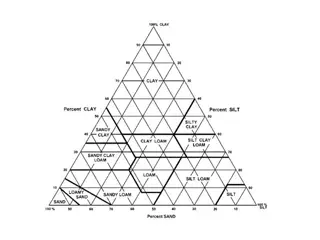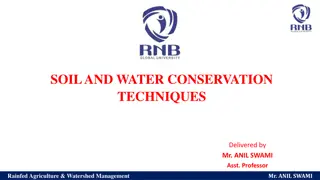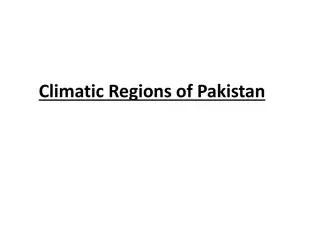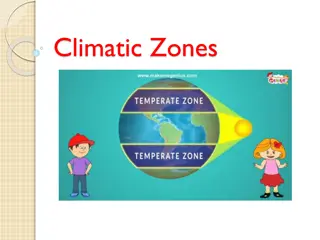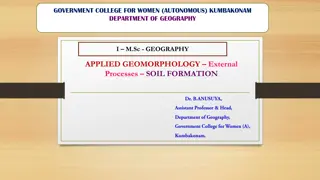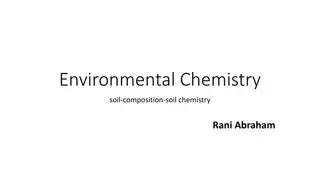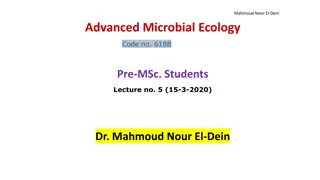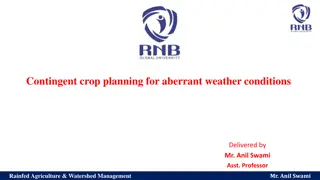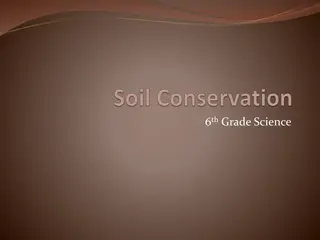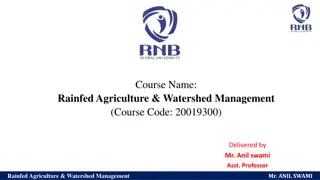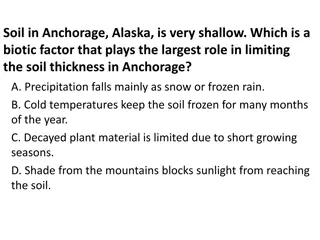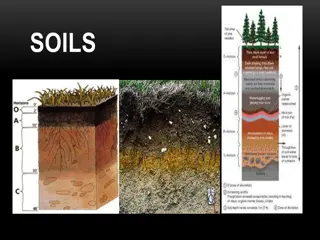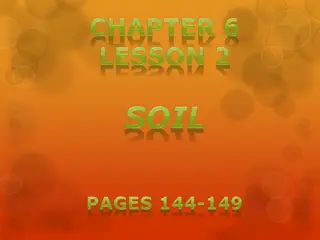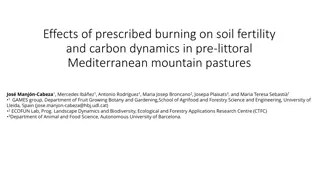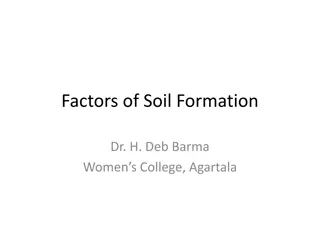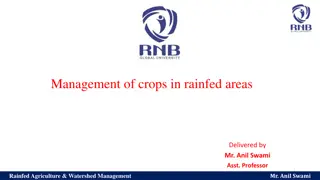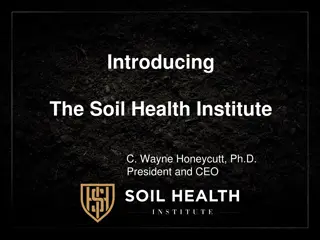Soil and climatic conditions in rainfed areas
The prevalent soil and climatic conditions in rainfed areas are discussed, focusing on water harvesting techniques, crop planning for erratic weather, and soil conservation methods. Different types of dry land soils in India and their characteristics are also explored.
Download Presentation

Please find below an Image/Link to download the presentation.
The content on the website is provided AS IS for your information and personal use only. It may not be sold, licensed, or shared on other websites without obtaining consent from the author.If you encounter any issues during the download, it is possible that the publisher has removed the file from their server.
You are allowed to download the files provided on this website for personal or commercial use, subject to the condition that they are used lawfully. All files are the property of their respective owners.
The content on the website is provided AS IS for your information and personal use only. It may not be sold, licensed, or shared on other websites without obtaining consent from the author.
E N D
Presentation Transcript
Soil and climatic conditions prevalent in rainfed areas Delivered by Mr. ANIL SWAMI Asst. Professor 1 Mr. ANIL SWAMI Mr. ANIL SWAMI Rainfed Agriculture & Watershed Management Rainfed Agriculture & Watershed Management
Objective:- Tell the soil and climatic conditions prevalent in rainfed areas. Interpret various water harvesting techniques and their efficient utilization. Apply contingent crop planning for aberrant weather conditions. Examine the seasonal rainfall and different types of watershed and its components. Select soil and water conservation techniques to avoid their losses. 2 Mr. ANIL SWAMI Rainfed Agriculture & Watershed Management
Soil Soil is the uppermost part of the earth crust containing a mixture of minerals. It is a three-phase system containing solid, liquid and gaseous components existing in certain equilibrium. 3 Mr. ANIL SWAMI Rainfed Agriculture & Watershed Management
Ideal dry land soils Soil texture has a profound influence on the productivity of soil. In general depth, texture, structure, drainage conditions and soil moisture relationship are very important soil properties, which decide the crop growth. Advantages and disadvantages of coarse and fine textured soils regarding crop cultivation are listed in Table 4 Mr. ANIL SWAMI Rainfed Agriculture & Watershed Management
5 Mr. ANIL SWAMI Rainfed Agriculture & Watershed Management
Dry land soils and their characteristics: In India, dry land occurs in almost all the regions of the country and the major soil types in these dry regions are red soils (Alfisols), black soils (Inceptisols and Vertisols), Laterite soils (Ultisols) and desert soils (Aridisols). The characteristics, features of the major soil groups and the prospects for raising crops in these soils under dry land conditions are described hereunder. 6 Mr. ANIL SWAMI Rainfed Agriculture & Watershed Management
Red soils (Alfisols) : Red soil is an important soil group in India and especially in dry land. These soils are moderately weathered and derived from granites, gneiss and other metamorphic rocks, either in-situ or from these decomposed rock materials washed down to lower level by rain. They are generally red or reddish brown or yellowish brown in colour due to the coating of ferric oxides on soil particles. 7 Mr. ANIL SWAMI Rainfed Agriculture & Watershed Management
Morphological types are red loams and red earth with loose topsoil. Main features of red soils are light texture, friable structure, absence of lime concretions and free calcium carbonates and contents of soluble salts. These soils are slightly acidic to slightly alkaline nature, medium in cation exchange capacities and near base saturated. Dominant clay mineral is k Kaolinite with an admixture of Illite. 8 Mr. ANIL SWAMI Rainfed Agriculture & Watershed Management Red soils are well drained with a moderate permeability.
Excessive gravel, surface crust formation and susceptibility to erosion in high slopes are some of the problems in these soils. They are low in organic matter content and nutrients like nitrogen and phosphorus. Occasionally, micronutrients like zinc is deficient in red soils. Potassium content in these soils is generally adequate for raising crops and the soil pH range is 6 to 7. Most of the red soils have been classified in the order alfisols and these types of soils occur widely in the states of Andhra Pradesh, Bihar, Assam, TN, West Bangal, Goa, Daman, Diu and parts of Kerala, Maharastra and Karnataka. 9 Mr. ANIL SWAMI Rainfed Agriculture & Watershed Management
Crop cultivation in red soils under dry land conditions: Rooting depth of crops is affected in the red soils as it consists of distinct gravel and weathered rock fragments. Crops grown under red soils in dry land conditions are susceptible to drought if the rainfall is poorly distributed during the cropping season. The soil lacks aggregation property leading to surface roughness, rapid seal of the soil surface after rainfall and results in soil crusting on drying. Tilling the soil is easier on wet conditions, but becomes hard and difficult on drying. 10 Mr. ANIL SWAMI Rainfed Agriculture & Watershed Management
Tillage with high wetness may lead to compaction and ploughing will be perfect only under limited soil moisture conditions. Establishment of a good crop is risky and the rapid surface drying due to poor rainfall distribution may affect the crop growth under dry land conditions in the red soils. Cultivation of crops will increase the infiltration initially, but in due course, the rate of infiltration will be reduced. Soil erosion will be less in presence of crops or vegetation in red soils and on denudation or allowing the land, as fallow will lead to high runoff and erosion. 11 Mr. ANIL SWAMI Rainfed Agriculture & Watershed Management
Leaching of nutrients is common due to its well-draining capacity, which necessitates adequate and frequent application of nutrients in red soils. Groundnut, sorghum, pearl millet, fox tail millet, red gram, green gram, cowpea, castor and horse gram are suitable crops for red soils. Groundnut + red gram, Groundnut + castor, sorghum+ red gram are the profitable intercropping systems which help in preventing crop loss during drought years. 12 Mr. ANIL SWAMI Rainfed Agriculture & Watershed Management
Table: Improved technologies for red soils Sr. N o. 1. Land & water manage ment Technolog y Aims Suggestions/ Observations Establishment of vegetation cover on bunds Formation of graded bunds Growing vegetative filter strips on contours Summer ploughing Contour tillage in slope lands Opening of dead furrows (at 10 feet interval) Construction of dugout pond For soil depth more than 20 cm, deep tillage once in three years for better infiltration of rainwater and to reduce pest and weed problems Mulching with agricultural waste @ 5 t/ha, within 10 days after sowing of crop to prevent evaporation losses. Water harvesting in farm ponds and subsequent use as supplementary/ lifesaving irrigation to increase yields of rain fed crops. Realigning and strengthening of field boundary bunds conservation of soil and water or for 13 Mr. ANIL SWAMI Rainfed Agriculture & Watershed Management
Depending on amount and distribution of rainfall and retention capacity of soil Following double cropping / intercropping / sequential cropping In case of surface crusting, application of sand @ 40 t/ha before sowing to decrease the crust strength, to facilitate better infiltration of water into soil and to improve germination and crop stand Intercropping with pulses reduce runoff losses, reduce soil erosion, conserve more moisture, add more organic matter in the soil and ultimately improves soil productivity 2. Crop manag ement Cropping season coincidence with period rainfall. Double cropping deep medium soils in safe of in and 14 Mr. ANIL SWAMI Rainfed Agriculture & Watershed Management
Application of phosphate fertilizers Application of nitrogen in splits with sufficient moisture Crop residue addition to improve soil physical properties Addition of other nutrients as per soil test 3 . Fertility manage ment Increasing the response to applied nutrients especially phosphorus crop 15 Mr. ANIL SWAMI Rainfed Agriculture & Watershed Management
Black soil (Vertisol/ inceptisol) Black soils are another important group of soils that occur in dry land conditions. They are characterized by dark Grey to black colour, high clay content, neutral to slightly alkaline in soil reaction and developing deep cracks during summer season. These are locally known as black cotton soil. Depth of the soil varies ranges from a low of 50 cm to several metres and in many cases it overlies decompose rocks (parent material) known as murram. 16 Mr. ANIL SWAMI Rainfed Agriculture & Watershed Management
Black soil are formed from Deccan basalt trap rocks either in-situ or on the transported parent material. In the formation of black soils, presence of a high proportion of alkaline earth in the weathering complex is of great importance. These soils have impeded drainage and low permeability. It occurs in areas under monsoon climate, mostly in semi-arid and sub humid type. 17 Mr. ANIL SWAMI Rainfed Agriculture & Watershed Management
High clay content and montmorillonite type of clay mineral impart high swelling and shrinkage properties of these soils. Black soils are low in organic matter content, available nitrogen and phosphorus and sometimes zinc, but reach in base nutrients like calcium, magnesium and potassium. Soil pH is in the range of 7.5 to 8.5. Soil is highly clayey and the clay content varies from 35 to 60% and sometimes up to 80%. 18 Mr. ANIL SWAMI Rainfed Agriculture & Watershed Management
These soils are characterized by high swelling and shrinkage, plasticity and stickiness. Black soils are generally calcareous neutral to slightly alkaline in reaction, high base status and high cation exchange capacity. They possess high soil moisture holding capacity. 19 Mr. ANIL SWAMI Rainfed Agriculture & Watershed Management
Runoff is severe in black soil and it is prone to erosion and the soil loss is estimated to be in the range of 6 to 8 t/ha per year. Shallow black soils on slopes have been classified in the order of Entisolsl and Inceptisols, while the deep medium black soils in the order of Vertisols. Black soil occur extensively in the states of Maharashtra, Madhya Pradesh and parts of Andhra Pradesh, Gujarat and Tamilnadu. 20 Mr. ANIL SWAMI Rainfed Agriculture & Watershed Management
Table: Improved Technologies for black soil Sr. TechnologyAims Suggestions/ Observations No. Promotion of intake of Construction of water storage structures like farm 1 Land & Water water in soil ponds Improvement of aeration Following watershed concept Application of FYM manageme nt and workability @ 20 tons per hectare for better infiltration of Reduction in soil erosion water Formation of graded Bund and runoff Facilitation of safe disposal Formation of a channel with a slope of.1- 0.25% of excess water along the graded Bund and merging this channel into a grassed waterway to drain water without any soil erosion 21 Mr. ANIL SWAMI Rainfed Agriculture & Watershed Management
Reduction in Runoff Rough with ridges and furrow to 2 Land configuration facilitate ponding of water Blade harrowing after receipt of loosening of soil after 3 Dry season tillage harvest of post rainy Premonsoon rain to break season crop Utilisation of first rain, Placing seeds in 5 cm death 4 Pre-monsoon Good results reported in crops of dry seedling ensuring early establishment of sorghum, cotton, main sunflower iI, crops and reduction green gram, red gram and poor results in the difficulty in reported in in pearl millet, soybean and planting in wet and groundnut sticky soil 22 Mr. ANIL SWAMI Rainfed Agriculture & Watershed Management
Increasing the crop Best suited to areas with moderately 5 Improved cropping system productivity and Returns dependable and favourable rainfall>750 mm 6 Fertility management Increasing the crop Recommendation as per soil test/ response to applied application of nitrogenous fertilizers nutrients especially nitrogen Low cost and maintenance Following integrated pest management 7 Pest management of environment (pesticides practices used only at threshold level of pests) 23 Mr. ANIL SWAMI Rainfed Agriculture & Watershed Management
Crop cultivation in black soils and dry land conditions A large area with Vertisols is under dryland conditions in India. Black soil is more productive than red soil. Important crops grown under the soils are coarse grains, cotton, oilseeds and pulses. Growing of crops is possible during post-rainy season (rabi season) with stored up soil moisture in shallow black soils (Entisols). 24 Mr. ANIL SWAMI Rainfed Agriculture & Watershed Management
In case of medium and deep black soils (i.e. Vertisols/ Inceptisols), growing crops is possible in season and post rainy season which stored up soil moisture (double cropping) depending on the quantity and distribution of rainfall. Cotton, Sorghum and other millets, pulses; especially chickpea, chillies, sunflower, safflower and coriander are suitable crops. 25 Mr. ANIL SWAMI Rainfed Agriculture & Watershed Management
Laterite soils (Ultisols) Laterite soils are well-drained soil with good hydraulic conductivity. They are formed by soil forming process called laterization. Laterite is a geological term, which means literally rock. Under high rainfall conditions, silica is released and leached downwards and upper horizons of the soil become rich in oxides of iron and Aluminium. 26 Mr. ANIL SWAMI Rainfed Agriculture & Watershed Management
This process is called laterization . Laterites are subdivided into high and low level laterites. High level laterites are found capping the summits of hills and plateau of the high lands and they are not useful for agriculture as they are thin and gravely. 27 Mr. ANIL SWAMI Rainfed Agriculture & Watershed Management
Low level laterites comprising of clay and loam occur in coastal regions on both sides of the peninsular region and are of considerable agricultural importance. Laterization is intensified with increase in rainfall with low intensity. 28 Mr. ANIL SWAMI Rainfed Agriculture & Watershed Management
Texture of a laterite soil is generally loam in top layers and depth of the loamy layer varies and in eroded nature. These soils are Pale, gritty, shallow and poor in plant nutrients in top layer. Soils in lower layers are of fine texture, darker and rich in plant nutrients and organic matter. All laterite soils are very poor in base materials like calcium and magnesium. The pH of the soil is low and acidic in nature. 29 Mr. ANIL SWAMI Rainfed Agriculture & Watershed Management
Soil clay type is generally kaolinite with traces of illite. Most of the laterite soils are classified under the order ultisols. These soils are well developed on the summits of Hills of the Deccan, Karnataka, Kerala and Madhya Pradesh, the Ghat regions of Orissa, Maharashtra, Kerala, West Bengal, Tamil Nadu and Assam. 30 Mr. ANIL SWAMI Rainfed Agriculture & Watershed Management
Crop cultivation in laterite soils under dry land conditions At lower elevations, suitable crops for cultivation under dryland conditions are rice (either single or double cropping), minor millets, trees and shrubs. Soil and moisture conservation measures may become necessary in regions of low to medium rainfall. At higher elevation in laterite soil plantation crops like tea, coffee, cinchona, rubber and cashew are grown. 31 Mr. ANIL SWAMI Rainfed Agriculture & Watershed Management
Desert soil (Aridisols) These soils occur in hot desert region in India. Rainfall of the region is ranging from as low as 50 mm to the highest of 400 mm of which the major portion is received during monsoon season. Potential evapo-transpiration is very high and showing aridity. 32 Mr. ANIL SWAMI Rainfed Agriculture & Watershed Management
A major part of the region consists of sand dunes and undulations. A zone of accumulation of lime concretions at a depth of 60 to 120 cm and presence of alkaline earth carbonate are common futures of this type of soils. Clay content is very low ranging between 2 to 8% and presence of sodium clay make the soil susceptible to dispersion and less permeable. 33 Mr. ANIL SWAMI Rainfed Agriculture & Watershed Management
The pH of the soil ranges from 8 to 9. Clay type is illite with small amounts of kaolinite. Desert soils are classified under the order Aridisols. These soils are distributed in the regions of Rajasthan, southern Haryana and Punjab and northern Gujarat. 34 Mr. ANIL SWAMI Rainfed Agriculture & Watershed Management
Crop cultivation in desert soils under dryland conditions Soils are light textured and the moisture holding capacity and nutrient availability are less. They are generally poor in available nitrogen and phosphorus. Soil salinity is a common problem and effective soil depth is influenced by the presence of calcium and carbonate concretions at various depth. Crop cultivation is possible only in deep soils either during kharif or rabi season based on the rainfall quantity and its distribution. 35 Mr. ANIL SWAMI Rainfed Agriculture & Watershed Management
Sub-Montane Soils Sub-montane soils occur in undulating lands of sub Himalayan regions under coniferous forest. Regions with sub-montane soils are characterized by high rainfall, accumulation of organic matter, absence of free lime and acidic nature. Landslides and soil erosion arecommon problems associated with sub-montane soils which lead to the leaching of bases. 36 Mr. ANIL SWAMI Rainfed Agriculture & Watershed Management
Crop cultivation in sub-montane soils under dry land conditions Soil moisture storage varies from 20 to 30 cm per metre soil profile. As the regions are characterized by high rainfall, double cropping is possible in sub-montane soils. Soils are low in available nitrogen and phosphorus and crops respond well to the application of N and P for higher productivity. 37 Mr. ANIL SWAMI Rainfed Agriculture & Watershed Management
Saline and sodic soils Saline and sodic soils occur mainly in arid and semi-arid regions of the country where the annual temperature are high and rate of evaporation generally exceeds rainfall. The situation leads to accumulation of salts in surface layers of the soil. In India, such soils are spreading over 8.5 million hectare of land and they are found with poor organic carbon, available nitrogen and Zinc. 38 Mr. ANIL SWAMI Rainfed Agriculture & Watershed Management
Saline soils contain excessively soluble salts and the dominant soil type are chlorides and sulphates of sodium, magnesium and Calcium. Total salt concentration as expressed by soil EC is generally more than 4 dS/ m. These soils are associated with water logging, saline groundwater and aridity. 39 Mr. ANIL SWAMI Rainfed Agriculture & Watershed Management
Sodic soils generally contain salts of carbonates and bicarbonates of sodium where the soil EC will be less than 4 dS/m and exchangeable sodium percentage more than 15%. These soils can be observed with stagnation of muddy water after rain for many days and they are very hard when dry and very soft when wet. Sodic soils contain insoluble calcium carbonate at high pH level (>9.5). 40 Mr. ANIL SWAMI Rainfed Agriculture & Watershed Management
Crop cultivation in saline sodic soils under dry farming conditions Reclamation Technologies for growing crops in Salt affected soil differ depending upon the availability of source of water. For areas which depend only on rainfall as the source of moisture, cultivation of salt tolerant plants species and planting techniques are recommended. Crops have been identified to salt stress conditions and few such crops which are sensitive and tolerant to soil salinity and sodicity under dry land conditions are given in table 41 Mr. ANIL SWAMI Rainfed Agriculture & Watershed Management
Saline soils Alkaline/ sodic soil Sensitive Tolerant Tolerant Highly sensitive Highly tolerant Direct sown Beans, rice, grasses like Legumes like green rice, wheat, pearl millet, Rhodes grass, barley, gram, black gram, lentil, barley, oats, mustard wheat, cotton, trees like gram and peas Amla, ber, Eucalyptus Medium Tolerant Sunflower, hybrid, Dalbergia sissoo, Moderate sensitive cotton, kernel grass, Trees like Terminalia arjuna Major and minor millets acacia, tamarind, ber 42 Mr. ANIL SWAMI Rainfed Agriculture & Watershed Management
Climate The behaviour of atmospheric phenomenon at a given place and time is defined as weather and the composite day-to-day weather elements for a given place or region over a period is referred as climate. 43 Mr. ANIL SWAMI Rainfed Agriculture & Watershed Management
Dry climate A dry climate is one in which the average annual precipitation is definition in relation to evaporation. It can be divided into arid and semi-arid climate. 44 Mr. ANIL SWAMI Rainfed Agriculture & Watershed Management
Arid climate It can be defined as an extreme dry climate where the average annual precipitation is less than 500 mm and usually in the range of 250 to 500 mm. Generally, the rainfall is well short of evapotranspiration demand of the atmosphere. The precipitation is insufficient for crop production. 45 Mr. ANIL SWAMI Rainfed Agriculture & Watershed Management
Semi-arid climate It can be defined as a climate where the average annual precipitation is greater than 500 mm and generally, crop production is possible with dry farming methods or with supplemental irrigation. The tropical retreat and semi-arid climate I have many features in common the distinct character of this climate is lake of sufficient rainfall to sustain crop production. They are centre on the latitudes from 20 to 25 degree north and South. 46 Mr. ANIL SWAMI Rainfed Agriculture & Watershed Management
Climate largely limits crop and animal production, ensures the human comfort, influences on health determine clothing and housing etc. Its influence on agriculture is enormous throughout the world and in a country like India where agriculture is the backbone of development, importance is manifold. The success of failure of farming is closely related to the prevailing weather condition. 47 Mr. ANIL SWAMI Rainfed Agriculture & Watershed Management
However, there are possibilities to optimise farm production by existing cropping pattern and agronomic practices to suit the climate of a locality. Weather resumes significance in nearly every phase of Agricultural activity from the preparatory tillage to harvesting and storage. Therefore, a sound knowledge of climate factors and an understanding of the complex processes of interaction between the climate and the biological processes of the plants are essential to a scientific approach on farming. The principal climatic factors limiting crop production in the order of priority under dryland conditions are precipitation temperature, sunlight, wind length of growing season etc. 48 Mr. ANIL SWAMI Rainfed Agriculture & Watershed Management
1. Effect of precipitation in dryland The common forms of precipitation are drizzle, rain, snow, sleet and hail. In dry lands rainfall limitation is the greatest factor in influencing the crop growth and yield. Rainfall plays a major role in determining the real potential of a crop and the region. It also has an influence on deciding the sequence and timing of farming operation and farming system 49 Mr. ANIL SWAMI Rainfed Agriculture & Watershed Management
General advantages of precipitation Recharge of groundwater Decision on various agricultural operations Decision on pattern of land utilisation Selection of crops, varieties, cropping and farming system Storage in reservoirs Decision on vegetation Development of irrigation sources Hydro power generation. 50 Mr. ANIL SWAMI Rainfed Agriculture & Watershed Management


